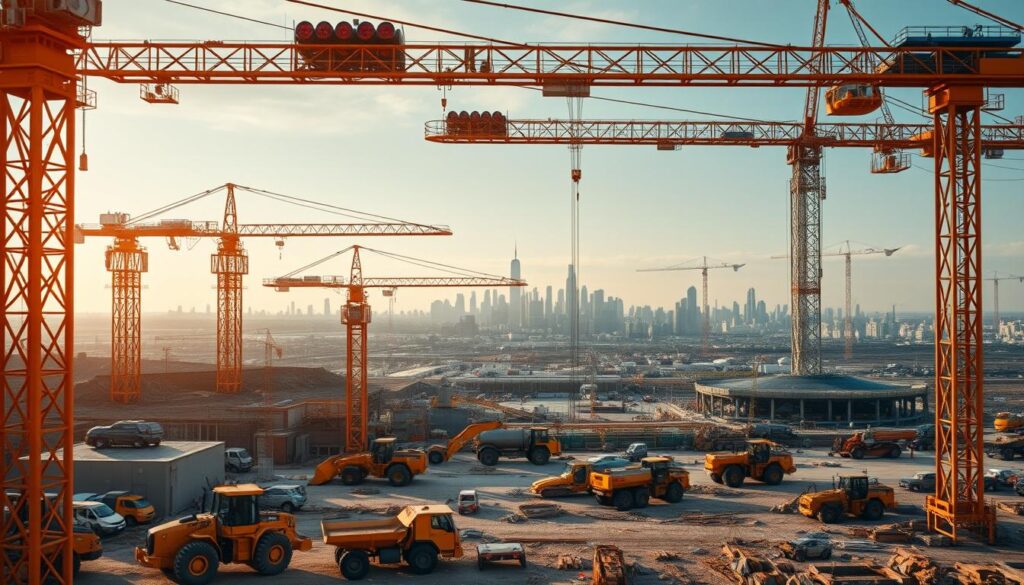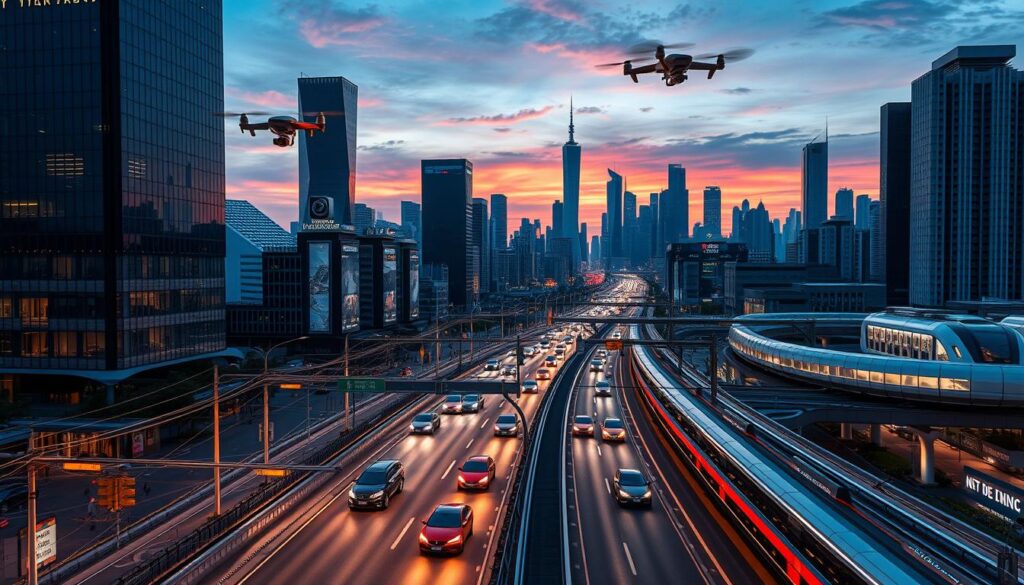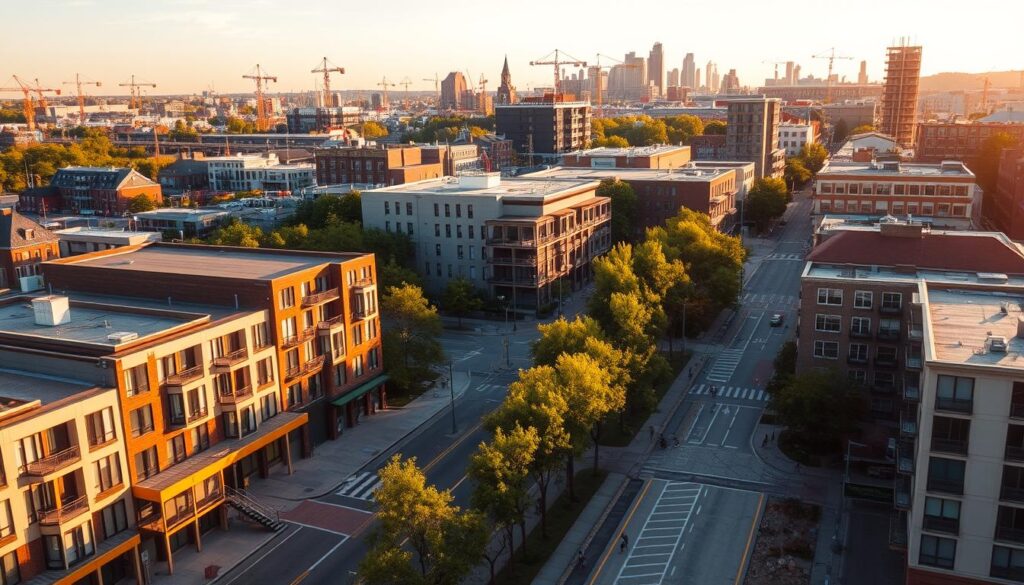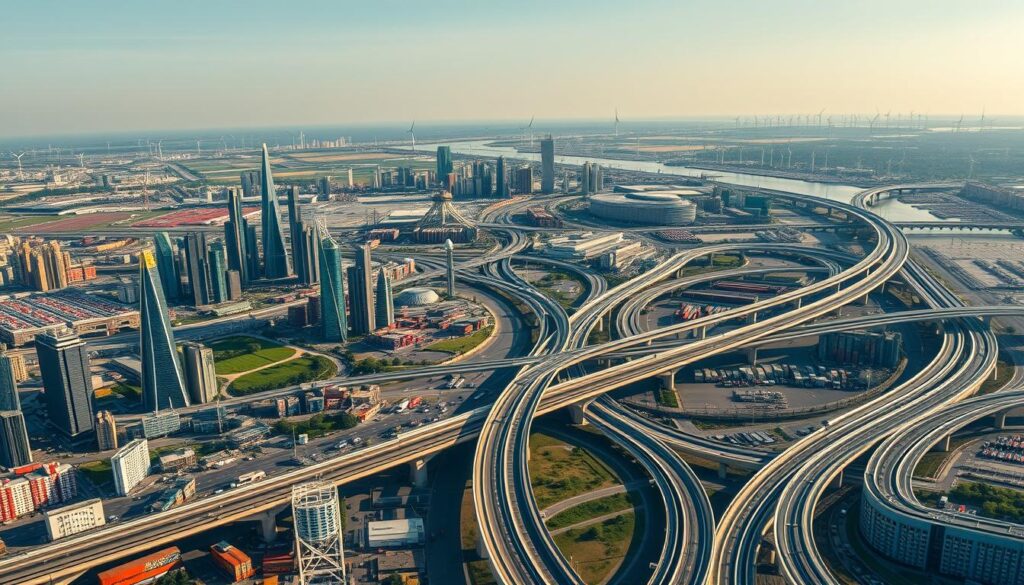Did you know that by 2050, nearly 70% of the world’s population is expected to live in urban areas? This rapid urbanization poses significant challenges for cities, including the need for sustainable and resilient infrastructure. Effective urban planning is crucial to address these challenges and ensure that cities can support their growing populations.
Effective project management is at the heart of integrated infrastructure development, enabling cities to coordinate the planning, design, and construction of various projects, minimizing disruptions, and aligning with broader community goals.
Key Takeaways
- Integrated infrastructure development is crucial for building resilient and sustainable communities.
- Effective urban planning is essential for supporting growing urban populations.
- Coordinating infrastructure projects minimizes disruptions and aligns with community goals.
- Sustainable cities require resilient infrastructure to support their populations.
- Proper project management is key to successful infrastructure development.
What is Integrated Infrastructure Development?
Integrated infrastructure development is a holistic approach that transforms the way we plan, design, and construct infrastructure projects. This comprehensive strategy considers the interconnectedness of various infrastructure elements, such as transportation networks, energy systems, and water facilities, to minimize disruptions and enhance overall efficiency.
Definition and Key Concepts
At its core, integrated infrastructure development involves coordinating the planning, design, and construction of infrastructure projects within the right-of-way. This approach ensures that different elements are managed cohesively, reducing the likelihood of future conflicts and improving the overall quality of infrastructure. Key concepts include infrastructure management and environmental impact assessment, which play crucial roles in ensuring that projects are both sustainable and effective.
| Key Components | Description | Benefits |
|---|---|---|
| Transportation Networks | Includes roads, railways, and public transit systems | Enhances mobility and connectivity |
| Energy Systems | Encompasses power generation, transmission, and distribution | Supports economic growth and reliability |
| Water Facilities | Covers water supply, treatment, and sanitation infrastructure | Improves public health and hygiene |
Importance in Modern Society
Integrated infrastructure development is crucial in modern society as it supports economic growth, improves the quality of life, and ensures environmental sustainability. By adopting a coordinated approach to infrastructure planning, cities can better manage resources, reduce the environmental impact of construction projects, and create more livable spaces. For more information on transportation networks, visit Transportation Network Engineering.
Furthermore, integrated infrastructure development facilitates the adoption of innovative technologies and practices, such as smart grids and green building techniques, which are essential for creating resilient and sustainable infrastructure. As cities continue to evolve, the importance of this integrated approach will only continue to grow.
The Benefits of Integrated Infrastructure Development

Investing in integrated infrastructure is a multifaceted approach that not only stimulates economic growth but also improves the overall quality of life. By focusing on sustainable and efficient infrastructure, cities can create a robust foundation for future development.
One of the primary benefits of integrated infrastructure development is its potential for job creation. Investing in sustainable infrastructure fuels job creation in various sectors, including renewable energy, construction, engineering, and urban planning. As noted by industry experts, “the shift towards green infrastructure is creating new job opportunities in manufacturing, installation, and maintenance of sustainable technologies” in the green infrastructure sector.
Economic Growth and Job Creation
Economic growth is another significant advantage of integrated infrastructure development. By enhancing transportation systems, energy networks, and water and sanitation facilities, cities can attract businesses and investments, thereby stimulating economic activity. For instance, improved transportation links can reduce logistics costs and increase access to markets, making a region more attractive to businesses.
- Enhanced connectivity through improved transportation systems
- Increased access to reliable energy and water services
- Creation of new job opportunities in construction and engineering
Moreover, integrated infrastructure development can lead to urban renewal, transforming neglected areas into vibrant, functional spaces. This not only enhances the aesthetic appeal of a city but also contributes to its economic vitality.
Improved Quality of Life
Beyond economic benefits, integrated infrastructure development significantly improves the quality of life for residents. Enhanced access to healthcare, education, and transportation services contributes to a healthier, more connected community. For example, efficient public transportation systems can reduce commute times, allowing more time for personal and professional activities.
“Investing in infrastructure is not just about building roads and bridges; it’s about building communities and improving lives.”
Infrastructure financing plays a crucial role in making these projects a reality. Innovative financing models and public-private partnerships can help secure the necessary funding, ensuring that projects are completed on time and within budget.
Key Components of Integrated Infrastructure
Creating a sustainable and resilient community requires a comprehensive infrastructure framework. This framework is made up of several key components that work together to provide the necessary support for daily life and economic activity.
Transportation Systems
Transportation systems are a critical component of integrated infrastructure. They include roads, highways, public transit systems, and pedestrian and cycling infrastructure. Effective transportation systems are essential for the movement of goods and people, connecting communities and facilitating economic growth. For instance, smart city initiatives often incorporate intelligent transportation systems (ITS) that use real-time data to manage traffic flow, reduce congestion, and improve safety.
Energy Networks
Energy networks are another vital element, providing the power needed for homes, businesses, and industries. These networks are evolving to incorporate more renewable energy sources, such as solar and wind power, making them more sustainable and less dependent on fossil fuels. The integration of smart grid technologies enables more efficient distribution and management of energy, reducing waste and improving reliability.
Water and Sanitation Facilities
Water and sanitation facilities are fundamental to public health and safety. These facilities include water treatment plants, distribution systems, and wastewater management infrastructure. Ensuring that these systems are well-maintained and efficient is crucial for preventing waterborne diseases and protecting the environment. Modern infrastructure development often includes innovative solutions for water conservation and management.
| Component | Description | Importance |
|---|---|---|
| Transportation Systems | Includes roads, highways, public transit, pedestrian, and cycling infrastructure | Essential for movement of goods and people, economic growth |
| Energy Networks | Provides power for homes, businesses, and industries, incorporating renewable sources | Critical for powering daily life and economic activity |
| Water and Sanitation Facilities | Includes water treatment, distribution, and wastewater management | Fundamental for public health and safety, environmental protection |
In conclusion, the key components of integrated infrastructure are interconnected and interdependent. By understanding and developing these components, communities can create a more sustainable, resilient, and thriving environment for their residents.
Challenges in Integrated Infrastructure Development

Despite its benefits, integrated infrastructure development faces numerous challenges that must be addressed. The complexity of such projects demands a multifaceted approach, involving various stakeholders and requiring significant resources.
Funding and Investment Issues
One of the primary challenges is securing adequate funding and investment. Infrastructure management requires substantial financial resources, which can be difficult to mobilize, especially in times of economic uncertainty.
The high upfront costs associated with infrastructure projects can deter investors, making it challenging to secure the necessary funding. Innovative financing models and public-private partnerships can help mitigate these issues by sharing the financial burden between government entities and private investors.
Environmental Concerns
Another significant challenge is addressing environmental impact assessment concerns. Infrastructure projects can have profound effects on the environment, including habitat destruction, pollution, and resource depletion.
Conducting thorough environmental impact assessments is crucial to identify potential risks and develop strategies to mitigate them. This includes adopting sustainable practices and incorporating green technologies into infrastructure development.
Regulatory Hurdles
Regulatory hurdles also pose a significant challenge to integrated infrastructure development. Complex regulatory frameworks can lead to delays and increased costs, hindering the progress of infrastructure projects.
Streamlining regulatory processes and fostering a collaborative environment between government agencies, private sector entities, and communities can help overcome these hurdles. This includes simplifying permitting processes and ensuring that regulations are clear and consistent.
Addressing the challenges in integrated infrastructure development requires a coordinated effort across governments, private sector entities, and communities. By understanding these challenges and working together, we can develop more effective strategies to overcome them.
The Role of Government in Infrastructure Development
Government policies and public-private partnerships are crucial elements in the successful development of modern infrastructure. Effective infrastructure development is not just about building roads and bridges; it’s about creating a sustainable, efficient, and equitable system that supports economic growth and improves the quality of life for citizens.
Policy Frameworks and Guidelines
Governments play a vital role in establishing policy frameworks and guidelines that guide infrastructure development. These frameworks ensure that infrastructure projects are aligned with national and local development goals, and that they are executed in a manner that is transparent, efficient, and environmentally sustainable.
Key aspects of policy frameworks include:
- Regulatory compliance
- Environmental impact assessments
- Community engagement
- Innovative financing models
By establishing clear guidelines, governments can encourage infrastructure financing through various channels, including public-private partnerships (PPPs), government grants, and private investment.
Public-Private Partnerships
Public-private partnerships (PPPs) have emerged as a critical mechanism for delivering infrastructure projects. PPPs allow governments to leverage private sector expertise and financing to deliver projects that might otherwise be unaffordable.
| Benefits of PPPs | Description |
|---|---|
| Increased Efficiency | Private sector involvement brings in innovative solutions and management practices. |
| Risk Sharing | PPPs allow for the distribution of project risks between the public and private sectors. |
| Access to Capital | PPPs can attract significant private investment, reducing the financial burden on governments. |
Effective urban planning is also crucial in infrastructure development, as it ensures that infrastructure projects are integrated into the broader urban landscape, supporting sustainable development and enhancing the quality of life for urban residents.
Innovations Driving Infrastructure Development

The future of infrastructure development is being shaped by groundbreaking innovations. As cities around the world strive to become more sustainable and resilient, new technologies and practices are being adopted to drive progress.
Smart Technologies
Smart technologies are at the forefront of infrastructure development, enabling cities to become more efficient and responsive to the needs of their citizens. Smart city initiatives involve the integration of technology into urban planning, resulting in improved public services and enhanced quality of life.
Some key features of smart city initiatives include:
- Advanced data analytics for informed decision-making
- IoT devices for real-time monitoring and management
- Smart grids for efficient energy distribution
Renewable Energy Solutions
Renewable energy solutions are critical for reducing the environmental impact of infrastructure development. By harnessing energy from sources such as solar, wind, and hydroelectric power, cities can significantly decrease their reliance on fossil fuels and lower their carbon footprint.
| Renewable Energy Source | Benefits | Challenges |
|---|---|---|
| Solar Energy | Abundant resource, zero emissions | Intermittent supply, high initial costs |
| Wind Energy | Low operational costs, scalable | Intermittent supply, noise and visual impact |
| Hydroelectric Energy | Reliable, low emissions | Dependent on water resources, high upfront costs |
For more information on innovations in infrastructure development, visit the United Nations’ page on the.
Sustainable Building Practices
Sustainable building practices are essential for minimizing the environmental impact of infrastructure development. This includes the use of eco-friendly materials, energy-efficient designs, and waste reduction strategies.
Some examples of sustainable building practices include:
- Using recycled materials in construction
- Implementing energy-efficient HVAC systems
- Incorporating green spaces into building designs
By adopting these innovations, cities can move towards becoming more sustainable cities, providing a better quality of life for their citizens while minimizing their environmental footprint.
Community Engagement in Infrastructure Projects
As cities evolve, the importance of community engagement in shaping infrastructure projects cannot be overstated, ensuring that developments are both sustainable and socially equitable. Community engagement is not just a procedural step but a vital component that influences the success and acceptance of infrastructure projects.
Importance of Stakeholder Input
Stakeholder input is crucial as it provides project developers with valuable insights into the needs and preferences of the community. This input can range from feedback on project designs to suggestions on how to minimize environmental impacts. Effective community engagement ensures that infrastructure projects are tailored to meet the actual needs of the community, thereby enhancing their relevance and acceptance.
Moreover, involving the community in the decision-making process helps in identifying potential issues early on, reducing the likelihood of project delays or cost overruns due to unforeseen opposition or legal challenges.
Building Public Trust and Support
Building public trust is fundamental to the successful implementation of infrastructure projects. When communities feel that their voices are heard and their concerns are addressed, they are more likely to support the project. Transparency and open communication are key elements in fostering this trust. By keeping the public informed about project progress, challenges, and benefits, project developers can build a positive relationship with the community.
Furthermore, public trust can lead to increased support for infrastructure projects, making it easier to secure funding and approvals. It also encourages community members to take an active role in the project’s success, potentially leading to better outcomes for everyone involved.
Case Studies of Successful Integrated Infrastructure Projects

By examining case studies of integrated infrastructure projects in major U.S. cities, we can identify best practices and lessons learned. These examples highlight the effectiveness of coordinated planning and investment in infrastructure management and transportation networks.
Examples from Major U.S. Cities
Cities like New York, Los Angeles, and Chicago have implemented comprehensive infrastructure projects that have transformed their urban landscapes. For instance, New York City’s redevelopment of the Hudson Yards is a prime example of integrated infrastructure, incorporating transportation networks, energy-efficient buildings, and public spaces.
Los Angeles has made significant strides in improving its transportation networks through the LA Metro Expansion Project, enhancing connectivity and reducing congestion. Similarly, Chicago’s infrastructure revitalization efforts have focused on improving water management systems and upgrading transportation infrastructure.
| City | Project | Key Features |
|---|---|---|
| New York | Hudson Yards Redevelopment | Transportation networks, energy-efficient buildings, public spaces |
| Los Angeles | LA Metro Expansion | Enhanced public transport, reduced congestion |
| Chicago | Infrastructure Revitalization | Water management systems, transportation upgrades |
Lessons Learned from Each Project
These case studies offer valuable insights into the planning and execution of integrated infrastructure projects. A key lesson is the importance of stakeholder engagement and public-private partnerships in securing funding and support. For more information on successful infrastructure projects, visit top civil engineering firms.
Another crucial aspect is the integration of sustainable practices and innovative technologies to enhance the efficiency and environmental sustainability of infrastructure projects.
The Future of Integrated Infrastructure Development
The next decade will witness significant advancements in integrated infrastructure, shaping a more sustainable future. As cities continue to grow and evolve, the need for efficient, resilient, and sustainable infrastructure becomes increasingly paramount.
Smart city initiatives are at the forefront of this transformation, leveraging cutting-edge technologies to enhance the quality of life for urban residents. By integrating data analytics, IoT devices, and advanced communication networks, cities can optimize resource allocation, reduce waste, and improve public services.
Trends to Watch
Several key trends are driving the future of integrated infrastructure development. Firstly, the adoption of renewable energy solutions is gaining momentum, reducing reliance on fossil fuels and mitigating climate change. Secondly, sustainable cities are focusing on green infrastructure, incorporating parks, green roofs, and green spaces to enhance urban biodiversity.
Another significant trend is the integration of smart technologies into infrastructure development. This includes the use of sensors, data analytics, and AI to create more efficient and responsive urban systems.
Predictions for the Next Decade
Looking ahead to the next decade, several predictions can be made about the future of integrated infrastructure development. We can expect to see increased investment in resilient infrastructure, designed to withstand the impacts of climate change and other external stressors.
Furthermore, smart city initiatives will continue to drive innovation, with cities competing to become the most attractive and sustainable places to live and work. This will involve not only technological advancements but also a focus on creating inclusive, equitable communities.
The development of sustainable cities will be a key priority, with urban planners and policymakers working together to create vibrant, thriving environments that balance economic growth with environmental stewardship.
The Impact of Integrated Infrastructure on Mobility

Integrated infrastructure plays a pivotal role in shaping the mobility landscape of modern cities. By creating comprehensive and interconnected transportation systems, cities can significantly enhance the mobility of their residents.
Enhancing Public Transport Options
One of the key ways integrated infrastructure impacts mobility is by enhancing public transport options. This includes the development of efficient bus networks, modern tram systems, and comprehensive subway lines. According to a report by CDM Smith, integrated public transportation systems can reduce travel times by up to 30%, making cities more livable and productive.
Key benefits of enhanced public transport include:
- Increased accessibility for all segments of the population
- Reduced traffic congestion through efficient routing and scheduling
- Lower emissions due to a decrease in personal vehicle usage
As cities continue to grow, the importance of well-planned public transport systems cannot be overstated. As noted by urban planning experts, “A well-designed public transportation system is the backbone of a sustainable city.”
Electric Vehicle Infrastructure
Another critical aspect of integrated infrastructure is the support for electric vehicle (EV) infrastructure. As the world shifts towards more sustainable modes of transportation, cities are investing heavily in EV charging stations and related infrastructure.
The development of EV infrastructure is crucial for several reasons:
- It encourages the adoption of electric vehicles, reducing reliance on fossil fuels.
- It helps in decreasing air pollution, contributing to a healthier urban environment.
- It supports the overall strategy of creating sustainable cities.
As
“The future of transportation is electric, and it’s being built into our cities today.”
This shift not only enhances mobility but also aligns with global efforts to combat climate change.
By focusing on both public transport and EV infrastructure, cities can create a more integrated, efficient, and sustainable transportation network. This not only improves mobility but also contributes to the overall quality of life for urban residents.
Environmental Sustainability in Infrastructure
As the world grapples with environmental challenges, the importance of sustainability in infrastructure development cannot be overstated. The construction and operation of infrastructure projects have significant environmental impacts, from energy consumption to material usage. Therefore, adopting sustainable building practices is crucial for minimizing these effects.
Eco-Friendly Construction Techniques
Eco-friendly construction techniques are pivotal in reducing the environmental footprint of infrastructure projects. Techniques such as using recycled materials, implementing energy-efficient designs, and minimizing waste contribute to sustainable infrastructure development. For instance, incorporating green roofs and walls into building designs not only reduces energy consumption but also enhances biodiversity.
Moreover, the use of locally sourced materials can significantly reduce the carbon footprint associated with transportation. By adopting such practices, the infrastructure sector can move towards more sustainable practices, as highlighted in resources like sustainable practices on infrastructure projects.
Minimizing Carbon Footprint
Minimizing carbon footprint is another critical aspect of environmental sustainability in infrastructure. This involves not just the construction phase but also the operational lifecycle of infrastructure projects. Strategies such as integrating renewable energy sources, enhancing energy efficiency, and promoting sustainable transportation options can significantly reduce carbon emissions.
Conducting thorough environmental impact assessments during the planning phase is essential for identifying potential environmental risks and opportunities for sustainability. By doing so, developers can implement targeted measures to mitigate adverse effects and enhance the overall sustainability of infrastructure projects.
In conclusion, environmental sustainability in infrastructure is a multifaceted challenge that requires a comprehensive approach. By embracing eco-friendly construction techniques and striving to minimize carbon footprint, we can create infrastructure that not only supports economic growth but also protects the environment for future generations.
The Social Aspect of Infrastructure Development

Infrastructure projects have the power to either exacerbate existing social inequalities or help mitigate them through thoughtful planning. As we develop infrastructure, it’s crucial to consider the social implications and strive for inclusivity, ensuring that all members of the community benefit.
“Infrastructure is not just about roads and bridges; it’s about people and places,” says Phil Myrick, a renowned expert in urban development. This perspective highlights the importance of considering the social fabric when planning infrastructure projects. By doing so, we can create spaces that promote social inclusivity and address issues of inequality.
Addressing Inequality Through Planning
Urban renewal initiatives are a prime example of how infrastructure development can be leveraged to address social inequality. By investing in disadvantaged areas, cities can stimulate economic growth, improve living conditions, and provide better access to services and opportunities. For instance, the redevelopment of public transportation systems can connect low-income neighborhoods to employment centers, enhancing economic prospects for residents.
Moreover, inclusive zoning laws and community land trusts can help preserve affordable housing options, preventing gentrification and displacement of long-time residents. As noted in a report on strengthening communities through social infrastructure, such approaches are vital for creating equitable urban environments.
Creating Inclusive Spaces
Creating inclusive spaces is another critical aspect of socially conscious infrastructure development. This involves designing public areas that are accessible, safe, and welcoming to diverse populations. Parks, plazas, and community centers can serve as hubs for social interaction, fostering a sense of community and belonging among residents.
To achieve this, urban planners can engage with local communities to understand their needs and preferences, ensuring that infrastructure projects reflect the character and aspirations of the area. By prioritizing urban renewal that is inclusive and equitable, cities can become more vibrant and just places for all.
In conclusion, the social aspect of infrastructure development is a critical consideration that can significantly impact the quality of life for community members. By addressing inequality through thoughtful planning and creating inclusive spaces, we can build a more equitable and thriving society.
Financing Integrated Infrastructure Projects
The development of integrated infrastructure demands substantial funding and creative financing solutions. As cities and countries strive to build sustainable and resilient infrastructure, they face significant financial challenges.
Innovative Financing Models
Innovative financing models are crucial for bridging the funding gap in infrastructure development. These models include:
- Public-Private Partnerships (PPPs): Collaborations between government agencies and private sector companies to finance, build, and operate infrastructure projects.
- Green Bonds: Specialized bonds issued to finance environmentally friendly projects, such as renewable energy installations or green buildings.
- Infrastructure Investment Trusts (InvITs): Trusts that allow multiple investors to pool their resources and invest in infrastructure projects, providing a steady income stream.
The Role of Impact Investing
Impact investing plays a vital role in financing integrated infrastructure projects by providing capital for initiatives that generate both financial returns and positive social or environmental impact. Impact investors seek to support projects that address pressing societal challenges, such as climate change, affordable housing, and access to clean water.
Some key aspects of impact investing in infrastructure include:
- Social Impact Bonds: Bonds issued to fund projects with specific social outcomes, such as reducing recidivism rates or improving educational outcomes.
- Sustainable Infrastructure Funds: Funds dedicated to investing in sustainable infrastructure projects, such as renewable energy or energy efficiency initiatives.
- Environmental, Social, and Governance (ESG) Criteria: Investment criteria that consider environmental, social, and governance factors in addition to financial returns.
By leveraging innovative financing models and impact investing, cities and countries can secure the necessary funding to develop integrated infrastructure that supports economic growth, improves quality of life, and promotes sustainability.
The Relationship Between Technology and Infrastructure

The future of infrastructure is deeply intertwined with technological advancements, from smart cities to innovative construction methods. As we look ahead, it’s clear that technology will play a pivotal role in shaping the infrastructure of tomorrow.
Smart Cities and IoT Integration
The concept of smart cities has gained significant traction, leveraging Internet of Things (IoT) integration to enhance the efficiency and sustainability of urban infrastructure. Smart city initiatives involve the use of sensors, data analytics, and connected devices to manage resources better, reduce waste, and improve public services.
For instance, smart traffic management systems can optimize traffic flow, reducing congestion and lowering emissions. Similarly, smart grids can manage energy distribution more efficiently, integrating renewable energy sources into the mix.
Advancements in Construction Technology
Construction technology is another area where significant advancements are being made. Innovations such as Building Information Modeling (BIM), modular construction, and the use of advanced materials are improving the quality, speed, and sustainability of infrastructure projects.
BIM allows for more precise planning and execution, reducing errors and delays. Modular construction enables the fabrication of building components off-site, which can then be quickly assembled on-site, minimizing disruption to local communities.
The use of advanced materials, such as high-strength concrete and fiber-reinforced polymers, is also enhancing the durability and sustainability of infrastructure. These materials can extend the lifespan of structures, reducing the need for frequent repairs and replacements.
How Local Governments Can Facilitate Development

Local governments play a pivotal role in shaping the future of their communities through integrated infrastructure development. By implementing effective policies and engaging with residents, they can ensure that infrastructure projects meet community needs and contribute to sustainable growth.
Local Planning and Zoning Policies
Effective urban planning is crucial for integrated infrastructure development. Local governments can facilitate development by creating comprehensive plans that integrate transportation, energy, and water management systems. According to McKinsey, governments can maximize their infrastructure investments by adopting a holistic approach to planning.
Zoning policies also play a significant role in shaping infrastructure development. By designating areas for specific uses, local governments can ensure that development is orderly and sustainable. For instance, zoning laws can encourage mixed-use development, reducing the need for lengthy commutes and promoting walkable communities.
| Zoning Type | Description | Benefits |
|---|---|---|
| Residential | Areas designated for housing | Promotes community living |
| Commercial | Areas for businesses and services | Boosts local economy |
| Mixed-Use | Combination of residential and commercial spaces | Reduces commute times, enhances livability |
Engaging with Residents
Community engagement is vital for the success of infrastructure projects. Local governments should actively involve residents in the planning process to ensure that their needs and concerns are addressed. This can be achieved through public meetings, surveys, and online platforms.
By engaging with residents, local governments can build trust and foster a sense of ownership among community members. This, in turn, can lead to greater support for infrastructure projects and a more collaborative approach to development.
In conclusion, local governments can facilitate infrastructure development by implementing effective planning and zoning policies and engaging with residents. By working together with the community, local governments can create sustainable, efficient, and responsive infrastructure that meets the needs of their residents.
The Global Context of Integrated Infrastructure Development

In today’s interconnected world, understanding the global context of integrated infrastructure development is crucial for success. Various countries are adopting different strategies, making it essential to compare these approaches and learn from international best practices.
Comparisons with Other Countries
Different nations face unique challenges and opportunities in infrastructure development. For instance, countries like Singapore and Denmark have made significant strides in integrating technology into their infrastructure, creating smart cities that are efficient and sustainable.
In contrast, developing countries often face challenges related to funding and resource allocation. However, they also present opportunities for innovative solutions, such as leveraging public-private partnerships to finance infrastructure projects.
- Singapore’s smart nation initiative has transformed its urban landscape.
- Denmark’s focus on sustainability has made it a leader in renewable energy.
- Countries like India are investing heavily in infrastructure to boost economic growth.
Learning from International Best Practices
International best practices offer valuable insights for countries looking to improve their infrastructure. For example, the Netherlands’ approach to flood protection and Japan’s advancements in earthquake-resistant construction are models that can be studied and adapted.
“Infrastructure development is not just about building roads and bridges; it’s about creating a sustainable and resilient future for our communities.” –
By examining these best practices, countries can avoid common pitfalls and accelerate their infrastructure development. This includes adopting sustainable building practices and leveraging innovative financing models.
- Adopting green building codes to reduce environmental impact.
- Utilizing advanced materials and construction techniques.
- Implementing smart grid systems to enhance energy efficiency.
Conclusion: A Vision for the Future
As we look to the future, the importance of integrated infrastructure development cannot be overstated. By adopting a holistic approach, we can create resilient, sustainable communities that support economic growth, improve quality of life, and protect the environment.
Building a Sustainable Tomorrow
Effective stakeholder engagement is crucial for the success of integrated infrastructure projects. By working together, governments, private sector entities, and local communities can ensure that infrastructure development meets the needs of all stakeholders.
Moving Forward Together
To achieve a more sustainable future, we must continue to invest in integrated infrastructure development and foster collaboration among stakeholders. This collective effort will drive innovation, enhance resilience, and create better living conditions for generations to come.
